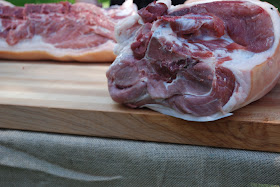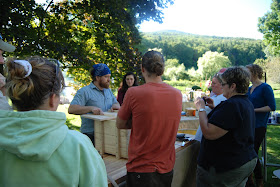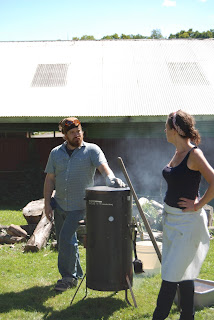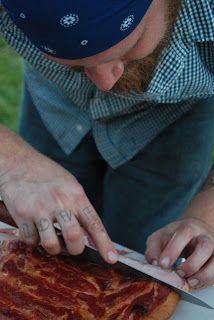Our leased land includes a large field that was cleared for building a jumbo house, and then the project was canceled, leaving acres of exposed shale. We call this area of our farm the "Shale Field." One of our goals on the farm is to use our animals to improve the health of the land we work- especially the Shale Field. When we moved to our new farm we put in a septic field, which left a large shale patch in the middle of our pasture. Through grazing, winter feeding (think manure and wasted hay), and spreading old hay, we were able to rehabilitate the area quickly and without adding seed (the seed in the hay fell out and volunteered in the new dirt that was created as the hay decomposed). We're hoping to do something similar on the Shale Field...except on a much, MUCH larger scale.
At any rate, we have had a bunch of thunderstorms lately and the Shale Field has turned into Shale Lake (a field of rock is not nearly as porous or absorbant as a field with vegetation!). My guess is that the lake is a couple of acres square and about ten inches deep.
During our last storm a tree fell on the pig fence abutting the new Shale Lake. As you might expect, some of the pigs went exploring. They didn't go far, and our pigs are rediculously easy to put back in their fence (a few apples and some milk and they were happily back in the fence in less than a minute). My sense is that pigs who live well don't feel as compelled to travel as those who live in mud, eating who knows what. It also helps that they're smitten with Colby.
It's hard to leave our farm, even leaving for the afternoon is a challenge most of the time. There are a lot of creatures depending upon us, and things rarely go as planned. On Monday, when the pigs were out, we were supposed to be at a pig roast (Our pig! YUM!). The pigs who were out were so content splashing in Shale Lake, rolling in the sand pile (not sure why, but there's a dump load of white play sand in the center of the field), and chasing apples that Colby was throwing for them that we just had to stay and play...and be a little late to the pig roast.
Honestly, being a farmer is a lot of hard work for little pay, but an afternoon like this, makes it worth it. Our kids were shrieking with joy, our animals were splashing and playing with our children, and we felt good about the way we do our job...even if we're always late to BBQs.
 |
| First pig ride. |
 |
| A lake with a view. |
 |
| Headed to the beach for a swim. |
 |
| ZOOM! |
 |
| Running around having a blast! |
 |
| Just a guy and his hogs. |
 |
| Splashing. |
 |
| Sand Castles anyone? |
 |
| Scratching in the sand. |
 |
| Rolling in sand. |
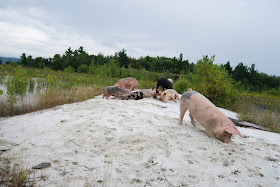 |
Our son wants to take them to the beach next time...
reasoning that we wouldn't have to find anyone to farm sit. |
 |
| First time digging sand. |
 |
| Playing with friends. |


















































